


IUCr Congress
Crystallography at the cutting edge
In real time, the XVII Congress and General Assembly of the International Union of Crystallography is scheduled to take place from August 8-17, 1996, but the "virtual" meeting has been on the Web since early June, accessible at http://www.bmsc.washington.edu/iucr/. The largest collection of abstracts for an International meeting ever assembled electronically (over 2250 from 65 countries) were placed on the web by the staff at the American Crystallographic Association office in Buffalo.
Crystallography is the bedrock of structural biology and materials science. The properties of matter whether of superconductors or enzymes are dependent on their three-dimensional structures. Today' s crystallographers are biologists, chemists, pharmacologists, database managers, physicists, engineers, mineralogists, forensic scientists, and kineticists. They probe structures with neutrons, X-rays, electrons and microscopes of all types (optical, electron, atomic force). Crystallographers are major users of neutron and synchrotron facilities throughout the world.
Forty percent of the 2250 one-page abstracts were submitted in hard copy and had to be scanned and edited prior to loading on the web. The 10% of the abstracts submitted in html include features that exploit the strength of the Internet where hyperlinks allow the author to present tables, illustrations, photographs and other data to augment their presentations.
The field of crystallography is so rich and productive that no less than 24 keynote lecturers and 104 microsymposia in seven parallel sessions are needed to begin to do justice to its full scope. There are full programs in materials science, chemical crystallography, macromolecular biochemistry, synchrotron radiation, neutron diffraction, computer technology, instrumentation and diffraction physics, and mathematical crystallography. Those who attend the Congress will not only find something of interest every day but may have to make difficult choices about which sessions to attend.
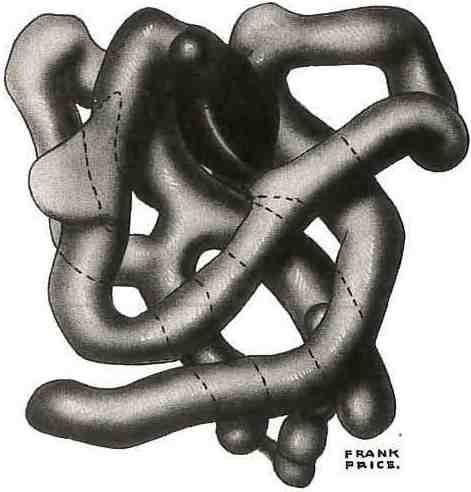 The first 6 Å resolution model of myoglobin, 1957. Photo courtesy of Sir John Kendrew.
The first 6 Å resolution model of myoglobin, 1957. Photo courtesy of Sir John Kendrew.
Each week the latest structural information revealed by crystallographic analysis is found in the pages of Science, Nature, Physics Today, and C&E News as well as in technical journals. A search of the contents of issues of Science, Nature, and Nature Structural Biology from December 1995 through June 1996 found not less than thirty two publications from thirty five of the crystallographers invited to speak in Seattle. The publications cover topics ranging from the structure of the core of the earth (C. Yoo, R. Hemley et al., Science, Dec. 1, 1995; C. Henderson, S. Redfern et al., Science March 22, 1996; Nature May 30, 1996) to structures at the core of human protein biosynthesis (P. Sigler et al., Science May 10, 1996; T. Kawashima, S. Cusack et al., Nature Feb. 8, 1996; J. Nyborg et al., Science Dec. 1, 1995) and include studies of the role of chaperonins in protein folding (X. Zhu, W. Hendrickson et al., Science June 14, 1996), cell adhesion proteins in invasive cancer (B. Nagar, J. Rini et al., Nature, March 28, 1996) and cover stories on the lac repressor complex with DNA (M. Lewis et al., Science, March 1, 1996) and a salt loving protein with an elevated capacity to bind water molecules (F. Frolow, M. Shoham et al., Nature Structural Biology, May 5, 1996). For a preview of what you will be reading in Science, Nature, Cell, Physics Today, and C&E News in 1997, come to Seattle in August.
The Scientific Program
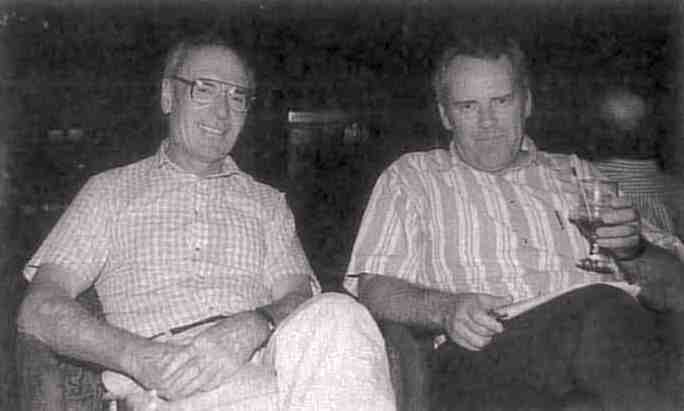 The architects of the Materials Program: Committee Members, Dave Cox (left) and Jim Jorgensen at the Montreal ACA meeting in 1995. Photo W.L.D.
The architects of the Materials Program: Committee Members, Dave Cox (left) and Jim Jorgensen at the Montreal ACA meeting in 1995. Photo W.L.D.
At the opening ceremony, the International Union of Crystallography will honor Michael Rossmann with its most prestigious award, the 1996 Ewald Prize for outstanding contributions to crystallography. Rossmann is the Hanley Professor of Biological Sciences at Purdue University in West Lafayette, Indiana. According to the prize citation, "his major contribution was (in cooperation with David Blow) the development of the molecular replacement method for the determination of phase angles and non-crystallographic symmetry." The citation continues, "the importance of this work, as well as his later work on viruses, is foremost among the triumphs of crystallography."
 A schematic representation of the structure of La2CuO4.032, from Physica C 170, (1990) 87-94 (photo courtesy of keynote speaker C. Chaillout).
A schematic representation of the structure of La2CuO4.032, from Physica C 170, (1990) 87-94 (photo courtesy of keynote speaker C. Chaillout).
Each morning from Friday, 9 August, through Saturday, 17 August the program will feature three speakers presenting keynote lectures in parallel from 8:30 to 9:30 am. The scientific sessions will be held from 10:00 am to 12:30 pm and from 3:30 to 6:00 pm, and the 4 two-day poster sessions are scheduled from 1:30 to 3:30 pm. Eight crystallographers who have been awarded Nobel Prizes are slated to give noontime lectures, from 12:45 to 1:45 pm from 12 August through 16 August. The noontime program on Thursday, 15 August, will be a round-table discussion at which all the Nobel laureates at the meeting will answer questions posed by young scientists.
The noontime program on Saturday August 10, "The ABZ's of DNA", will feature presentations by pioneers in atomic resolution X-ray crystal structure determinations of oligomers of DNA and their complexes with intercalating agents, R. Dickerson (UCLA, US) and O. Kennard (Cambridge, UK).
Four of the evening sessions will be devoted to the general assembly of the Union. Items on the Agenda include reports concerning the extensive publishing activities of the Union, the Union's plans for electronic publishing, the activities of the 14 scientific Commissions and three Regional Associates of the Union and consideration of applications for membership of new Adhering Bodies. There will also be evening sessions on the History of Crystallography, and Art and Crystallography.
- American Institute of Physics
- BioCryst Pharmaceuticals, Inc.
- Blake Industries
- Boehringer Ingelheim Pharmaceuticals
- Bristol Myers Squibb
- Charles Supper Company
- Dupont Merck Pharmaceuticals Company
- Enraf Nonius
- Glaxo Research Institute
- Hampton Research
- Hoffmann-LaRoche
- International Centre for Diffraction Data
- Mac Science Co., Ltd.
- Merck Research Laboratories
- Molecular Structure Corporation
- Monsanto
- Oxford Cryosystems
- The Procter & Gamble Company
- Rigaku International Corporation
- Siemans Analytical X-ray
- Smith Kline Beecham Pharmaceuticals
- The Upjohn Company
- X-ray Research, GMBH
The Social Program
The ten-day event will kick off with an opening ceremony at 4:30 pm on Thursday, 8 August, at the 5th Avenue Theatre, and a welcoming reception in the Bell Harbor Conference Center on the waterfront. On Tuesday, 13 August, conference participants can join one of several planned excursions in and around Seattle. Or, they might choose to sign up for half-day workshops dealing with the crystallographic information file (morning session for beginners, afternoon for veterans) or a workshop on surfing the crystallographic net. That evening all are invited to enjoy food, emertainment, and exhibits at the Pacific Science Center from 7 to 10 pm.
The Congress banquet will be held Thursday, 15 August, at 7:00 pm in the Grand Ballroom of the Sheraton. The ACA's Young Scientist Special Interest Group is sponsoring a mixer for the young crowd on Saturday night at 7 pm.
The Exhibit
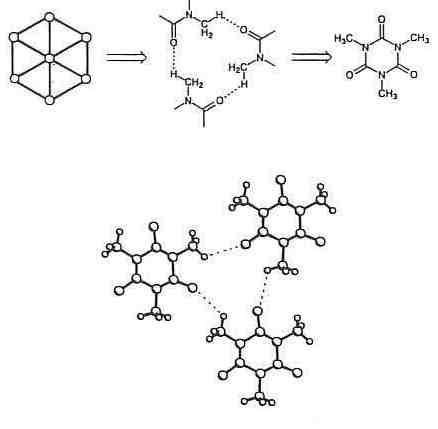 In his keynote lecture Gautam Desiraju will discuss crystal engineering, the supramolecular equivalent of organic synthesis.
In his keynote lecture Gautam Desiraju will discuss crystal engineering, the supramolecular equivalent of organic synthesis.
At the exhibition show, conference participants can look over the latest instruments and techniques for sample isolation, purification and preparation, as well as for crystal growth and data collection; computer software for data storage, retrieval and analysis; graphics systems and databases; and books and journals. The show, organized by the American Institute of Physics, will run from Saturday afternoon, 10 August, through Thursday, 15 August, except for Tuesday, the excursion day. On Saturday the show hours are 1:30 to 5:30 pm. On Sunday, Monday and Wednesday, the show will go all day, from 9:30 am to 5:30 pm, and on Thursday, the hours will be from 9:30 am to 3:30 pm.
Congress Registration
The registration desk will open at 10:00 am on Thursday, August 8, on the fourth floor of the Washington State Convention Center and Trade Center (not in the Sheraton Hotel) where it will continue daily from 10:00 am to 7:00 pm.
As of June 24, the registration count had reached 2,050 of which 10% were students and 13% were accompanying members. A list of registrations was posted to the web and updated regularly.
Financial Assistance
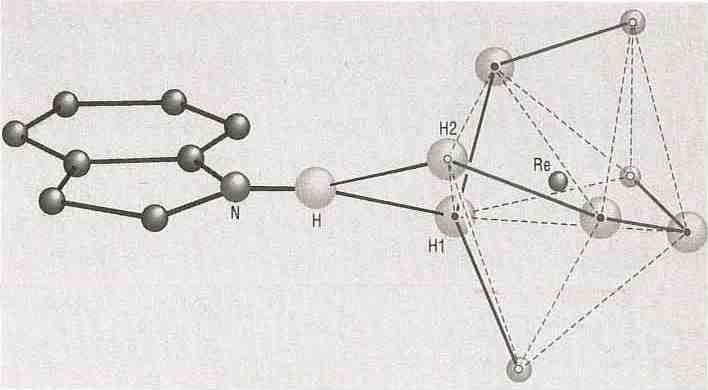 A novel rhenium hydride adduct showing a new type of hydrogen bonding will be discussed by Thomas Koetzle in his keynote lecture on neutron diffraction.
A novel rhenium hydride adduct showing a new type of hydrogen bonding will be discussed by Thomas Koetzle in his keynote lecture on neutron diffraction.
Over 300 applications for financial assistance were received. Three teams of reviewers appointed by the U.S. National Committee for Crystallography reviewed and ranked the proposals. The ranking of the 163 applicants for support in the young scientist program are tabulated according to geographical location and by research topics in Table 1.
Ranking of Applications for Support for Young Scientists By Geographical Location and Topic
| Rank1 | 20 | 40 | 60 | 80 | 100 | 120 | 140 | 163 | Total/163 | % |
|---|---|---|---|---|---|---|---|---|---|---|
| Europe | 12 | 11 | 9 | 9 | 12 | 14 | 11 | 9 | 87 | 53% |
| W. Hemisphere | 5 | 5 | 3 | 4 | 1 | 3 | 4 | 8 | 33 | 20% |
| Asia-Aus-Pac | 3 | 3 | 8 | 5 | 7 | 2 | 5 | 6 | 39 | 24% |
| S. Africa | 1 | 2 | 1 | 4 | 2% | |||||
| 163 | ||||||||||
| Macro | 7 | 9 | 5 | 6 | 6 | 4 | 8 | 12 | 57 | |
| Inorganic | 6 | 6 | 10 | 9 | 11 | 7 | 7 | 6 | 62 | |
| Org, Bioorg | 6 | 2 | 1 | 2 | 2 | 4 | 4 | 2 | 23 | |
| All Other | 1 | 3 | 4 | 3 | 1 | 5 | 1 | 3 | 27 | |
| Rank | 20 | 40 | 60 | 80 | 100 | 120 | 140 | 163 | 163 | |
| 1 Top 20, top 40 etc. | ||||||||||
Support generally consisting of a waiver of registration and "a dormitory package" was offered to the top ranking 88 students and 30 special needs applicants. The equidistribution along international lines as well as primary area of application is indicative of the high caliber of crystallographic research under way around the globe. The distribution of awards in the special needs category was in proportion to requests received as follows: 22 of 48 applications from Europe, 7 of 17 from the Pacific Basin, and 1 of 6 from the Western Hemisphere.
The participation of 14 crystallographers from the former Soviet Union selected from among 37 applicants was supported by the Logovaz Foundation.
Support
The Congress is being hosted by the U.S. National Academy of Sciences and National Research Council, through the agency of the U.S. National Committee for Crystallography. Reflecting the intensely interdisciplinary nature of contemporary crystallography, the Congress has attracted support from the American Crystallographic Association and American Institute of Physics, as well as from U.S. Governmental scientific agencies, including the Department of Energy, the National Science Foundation, the National Institutes of Health, and the National Institute of Standards and Technology, and numerous corporate donors.
This will be the largest gathering of crystallographers in the 80 year history of the field. The phenomenal turnout is attributed to:
- 24 Keynote lecturers and 105 microsymposia covering the application of the techniques of crystallography to an extraordinary range of materials.
- Presentations by 8 Nobel Laureates honored for their work in diffraction and crystallography.
- The availability of the abstracts on WWW accessible in many countries throughout the world.
- The availability of e-mail communications for abstract submission from remote, underdeveloped, and FSU countries.
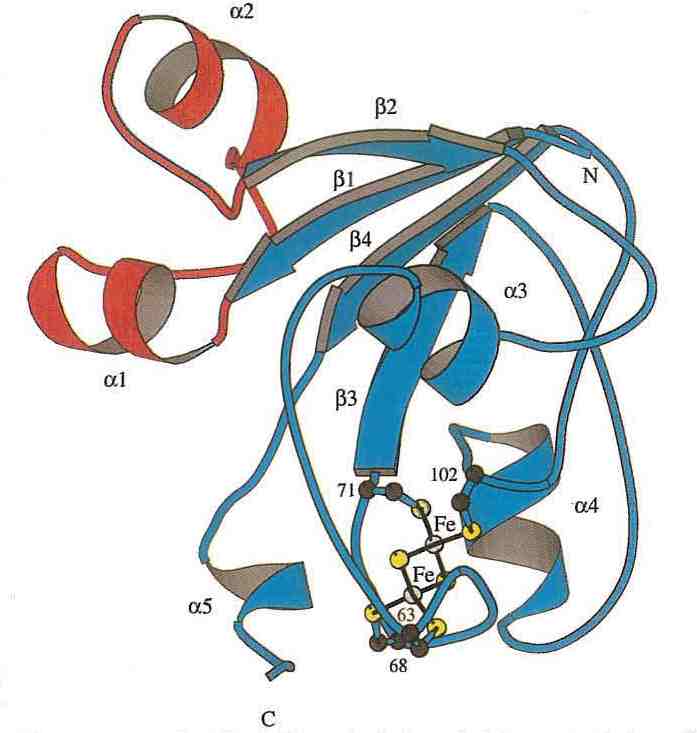 The structure of a 2Fe-2S ferredoxin from halobacteria that can live in the supersaturated salt solution of the Dead Sea (on the cover). The entire surface of the protein is covered with carboxylates except for the vicinity of the active site (F. Frowlow et al., Nature Structure Biology Vol. 3 1996, p. 452).
The structure of a 2Fe-2S ferredoxin from halobacteria that can live in the supersaturated salt solution of the Dead Sea (on the cover). The entire surface of the protein is covered with carboxylates except for the vicinity of the active site (F. Frowlow et al., Nature Structure Biology Vol. 3 1996, p. 452).
Open Commission, Ad Hoc and Users Meetings
Rooms are available in the Convention Center for commission, users, and other ad hoc meetings. Groups wishing to use this space should notify the Congress Secretariat as soon as possible. The schedule for such meetings arranged thus far follows:
| Topic/Chair | Room | Time |
|---|---|---|
| Friday August 9 | ||
| CSD Users and Distributors Chair: F. Allen |
611 | 1:30-5:30 |
| Electronic Publishing Committee Chair: S. Hall |
612 | 1:30-3:30 |
| Saturday August 10 | ||
| Open Comm. on Journals Chair: C. Bugg |
602-604 | 1:30-3:30 |
| Open Comm. on Elec. Diff. Chair: J. Steeds |
Sheraton 424 | 10:30-11:30 |
| Monday August 12 | ||
| Open Comm. on Charge Density Chair D. Feil |
Sheraton 424 | 10:00-11:00 |
| ACA Small Molecule SIG Chair: Jeanette Kraus-Bauer |
6A | 6:00 |
| Wednesday August 14 | ||
| ACA Service Crystallography SIG Chair: Jeanette Kraus-Bauer |
6A | 6:00 |
| Canadian ACA Group Chair: F.V. Evans |
611 | 2:30-3:30 |


